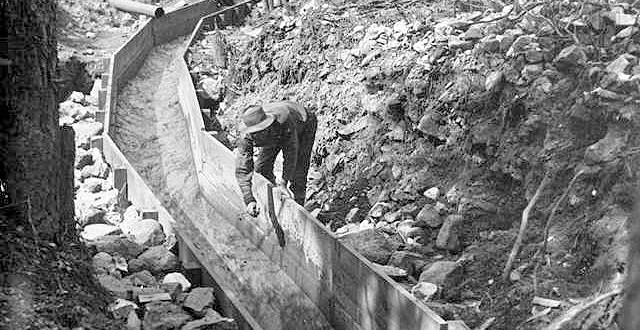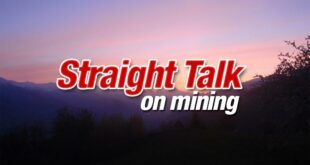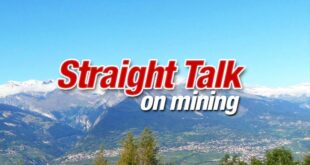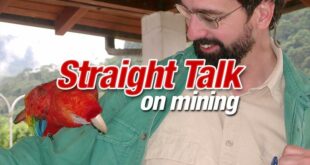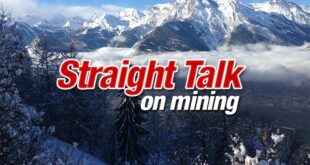Market commentary
Gold is now sitting at a 2 year high and things have never looked more golden.
Marshall McLuhan said “The medium is the message.” Many commentators overlook an extremely important factor in today’s market reality and that is getting your message out – not so much the content and what is said, but where it is said and by whom. Public relations and investor relations people know this all too well. The “medium” in this case is the mainstream press, which for years derided and poked fun at gold investments. Friday’s price rise caught the attention of the US Sunday papers, and there are major articles in today’s New York Times and Chicago Tribune. I have said for some time that when the rank and file cotton on to the gold market then watch out! While the gold story remains confined to the back pages of some industry publications it can’t grow. For some months now it has been the “stealth bull” – but with the aid of the popular press all things become possible.
We surmise that the paper shredders at a number of brokerage companies have been going into overdrive this past weekend. The scandal which first erupted at Merrill Lynch April 8th has spread like a contagion and now the Securities and Exchange Commission have announced a formal inquiry. Added to this are the first of we predict many class-action lawsuits aimed at recovering some of the Bubble assets which vapourized over the last year. The Boston law firm, Shapiro Haber & Urmy LLP have filed a class action suit against Merrill Lynch & Co., Inc. and Henry Blodget, a former analyst, alleging securities fraud. Merrill yesterday hired former New York mayor, Rudolph Giuliani as legal counsel. Giuliani has not worked in a courtroom in a decade. We can certainly be promised some high drama and a media circus with this one. The initial inquiry by New York Attorney General Elliot Spitzer reads like a Grisham novel, and can be found at http://www.oag.state.ny.us/press/2002/apr/MerrillL.pdf
The vultures are truly circling. It is all an invitation for black humour and I am already hearing jokes about it. The alleged actions of Merrill analysts – that they publicly touted companies while at the same time privately trashing them in E-mails and other correspondence sent all over the show, sounds like something from the Darwin Awards. The Darwin Awards website is one of my personal favourites. It commemorates “those who improve our gene pool by removing themselves from it in really stupid ways”.
There is another side of this story that is important – the whirlpool threatens to suck in a number of the firms who participate in the Gold Carry Trade or in the gold derivatives market. Already a number of the companies named in Reg Howe’s lawsuit have turned up again in the University of California class action lawsuit over the Enron debacle. Should this maelstrom cause the distress or collapse of any of the key players we could see all hell break loose. When Drexel Burnham went under a few years ago 17 tons of gold borrowed from the Bank of Portugal went “poof”. It is very difficult to get a true reckoning of how much central bank gold has been lent in similar ways, but one thing is sure that with rising bullion prices it will be more expensive for borrowers to pay it back.
The Alto Chicama discovery
On last Tuesday the 23rd, Barrick Gold Corporation announced a “significant gold discovery” of approximately 3.5 million gold ounces in Peru. My last commentary decried the dearth of new discoveries and hey presto! we have a brand new deposit.
According to Barrick’s press release, the company has calculated an “inferred resource” of 61 million tons grading 0.057 ounces per ton. This translates to a grade of 1.95 grams per metric tonne. Randall Oliphant, CEO and president of Barrick is quoted as saying “the similarities to our Pierina Property are striking, in terms of grades, good metallurgy, gold-rich surface outcroppings and the potential for expanding the resource.”
Also according to the press release, “the mineralization is disseminated and is hosted in volcanic and sedimentary breccias and tuffs. The deposit is of high sulfidation type and is similar in style to the mineralization at Barrick’s Pierina Mine.”
There’s not a lot of public domain information on Alto Chicama, but here’s what we were able to find:
Alto Chicama sits on the west flank of the Cordillera Occidental in the Andean Mountain chain, in the districts of Usquil and Quiruvilca in the provinces of Otuzco and Santiago de Chuco, 160 kilometres from the city of Trujillo and 550 kilometres north of the capital, Lima. Elevation is between 1,950 m and 4,150 metres.
Barrick won the Alto Chicama property in a tender from Centromin, the Peruvian government mining entity, in January, 2001. The property itself is listed as held by Minera Peru S.A. and we are not entirely sure what the Centromin connection is. Centromin had been dealing off its properties in a privatization drive. Barrick were the only bidders for Alto Chicama , and came in with an offer of 2.51% production royalty. The mandated minimum bid was 2.5%, hence the reason the accepted royalty figure is not a round number. Barrick agreed to expenditures of $US1 million in the first year, $US2 million in the second year, and $US3 million in the third year. At the end of year three Barrick must table a feasibility study and pay an advance royalty of $US2 million credited against Centromin’s net smelter royalty.
According to an article dated 16th of January, 2001, in the Peruvian newspaper Diario Gestión, which announced Barrick’s initial option agreement and winning bid, “recent studies have detected anomalies that indicate the probable presence of a disseminated deposit of gold in the Calipuy volcanics, over an area of 4 kilometres long by 2 kilometres wide.” Randall Oliphant has claimed that this is a Barrick grassroots discovery. The public record though would indicate otherwise.
Probably an unsung Peruvian geologist is ultimately responsible for the discovery.
The reason Barrick got this project so cheaply – basically for a future royalty and a work programme – was because Alto Chicama is known throughout Peru as the country’s largest deposit of anthracite coal! The project was promoted by the Peruvian government as a potential source of coal for electric power generation. That idea was nixed by the go-ahead for exploitation of the Camisea natural gas field, which will produce electric power much more cheaply. Development of Camisea made Alto Chicama unsaleable. Centromin then resorted to “plan B” and promoted the area as a potential gold play. The idea sounded so outlandish that I doubt anyone gave it credence. But according to “Economic Geology of the Alto Chicama, Santa, Oyon and Jatunhuasi Basins”, written in 1998 by Procarbon, the Cretaceous coal deposits are indeed partially overlain by younger Tertiary flows and breccias of andesite, dacite and rhyolite Calipuy volcanics – certainly the right type of rocks for a gold deposit, and in fact the same host rock as Pierina. If the gold resides in brecciated sediments and volcanics, as it would appear, then there is potential that Alto Chicama contains some carbonaceous ore. Carbon can be a “robber” of gold if it naturally occurs in the rocks, because gold in the other rock types will tend to bind itself to the carbon during heap leach processing. It can knock down recoveries, or cause a greater consumption of cyanide adding to costs. On the flipside, if Barrick indeed own the coal rights they can perhaps vend that deposit and offset their own costs. Once the infrastructure is in, the economics of exploiting the coal deposit may become attractive.
Oliphant didn’t mention any high grade resource numbers and we have to assume if Barrick had found significant high grade they would crow about it. Pierina had a high grade zone at surface that became known as “Payback Hill”, which made the deposit so incredibly economically attractive. It had grades >8 g/t, with spot grades up to 300 g/t Au. In December, 1996, proven and probable reserves at Pierina were 67.7 Mt grading 2.98 g/t – a resource much more robust than currently defined at Alto Chicama. A press story released by one of the wire services last Tuesday morning, (and expunged by mid-afternoon!) claimed that Alto Chicama could benefit from the proximity of La Pierina – possibly even through use of the existing mill. It was obvious nonsense, since the two are 175 kilometres away from each other, in mountainous terrain. No one is going to haul raw ore that kind of distance for milling. Whenever you see these kind of statements its always a good idea to do a back-ofthe- envelope calculation. Using the numbers in the press release the value of gold is less than $18 per ton of rock – that’s assuming 100% recovery. The resource numbers so far are of low grade, but the exploration group must be bullish about the gold price for the long term.
Obviously, someone within Barrick gave the order to check out the Alto Chicama area and they deserve a lot of praise. A $1 billion, ninety-two million dollar deposit acquired for an exploration commitment and royalty is one hell of a coup! Today, in the New York Times, Barrick was chastised for its allegiance to hedging; contrasting Barrick’s price performance over the last few months with Newmont. Barrick has lost its star performer status over the last several months. The discovery announcement though gave Barrick a much needed shot in the arm.
What a shame Alto Chicama wasn’t found by a junior company! The announcement would have sent them sky-high. Investors who remember the La Pierina discovery, know it catapulted junior Arequipa Resources into the big leagues. Arequipa Resources, a tiny junior out of Vancouver found what would become one of the world’s best gold mines with +7 million ounces. Between October, 1995 and end of October 1996 when it was bought out by Barrick, shares rose from $1.15 to $30.00; a 2509% increase! A price rise like that sounds like something out of the tech boom, but it did happen, and it wasn’t a scam.
Which leads me on to two other news stories:
Golden Star Resources Ltd. and BHP Minerals International Exploration Inc. have announced a 20:80 joint venture over an area of 104 square kilometres in northwestern Guyana. The “Cuyuni Property” as it is known, is being acquired from the Barama Company Ltd. for cash, a royalty interest, and other considerations.
Golden Star closed their Georgetown office a few years ago, and BHP left Guyana back in 1999. They had formerly been joint venture partners. Our guess is that BHP wanted to reinvestigate this area but there may have been an existing agreement still running, obliging BHP to take on Golden Star as a partner. The Cuyuni property is due east of the Kilometre 88 gold area, across the border in Venezuela, and there is a high probability of gold and copper deposits in the large property holding. It’s a great area to look, though remote and somewhat swampy, with poor access. Another factor which perhaps has enticed BHP has been the prospect for diamonds. Diamonds can be recovered from the Cuyuni River, and their source still hasn’t been found. BHP is a significant diamond producer with an operating diamond mine in Canada. Golden Star identified 78 kimberlite-type targets in northern Guyana on the “5 Stars Property” in something they termed the “Piai Head cluster” in 1997. A “kimberlitic” rock was later intersected in drilling. No doubt both Guyana diamonds and gold are on BHP’s radar. Golden Star is along for a free ride until a bankable feasibility study is completed, when presumably they will have to kick in some cash (maybe their share of start-up costs?)
Barrick Gold has also just signed a letter of intent with Rimfire Minerals, on their RDN Property, 40 kilometres south-southeast of Eskay Creek in British Columbia. The RDN Property is 21 kilometres long and occupies similar stratigraphy to Eskay Creek. We haven’t done an analysis of the area, but conceptually, determined exploration for another Eskay Creek is certainly worthwhile.
With these three stories; one of which is a resounding success, I want to underscore yet again that exploration can have really big payoffs – if an exploration programme is well-conceived, adequately funded, and staffed by experienced personnel. Sure it is risky, but the “elephants” are not going to be found in areas that have been pincushioned with drill holes over a fifty year period. Exploration requires vision, innovation, and a certain amount of “outside the box” thinking.
Steps in the Exploration Process
I promised an item on “area selection” for exploration, though space constraints won’t allow justice to the topic this week. I’ll borrow from the Society of Economic Geologists, Special Publication #3, “Ore Reserve Estimates in the Real World” (third edition). It is chocked full of goodies and I urge anyone who wants to get into the nuts & bolts of deposit delineation to get a copy:
- (a) Conception (Idea) Stage: Selection of areas and/or district in which to conduct exploration. Literature search with some field investigation.
- (b) Reconnaissance Stage: Broad-scale prospecting. Airborne geophysics, regional geologic mapping, stream sediment geochemical surveys, etc. Purpose is to screen a large area for existence of potential targets warranting detailed work.
- (c) Land Acquisition: Stake claims, lease large blocks of ground with few or no known mineral showings.
- (d) Detailed Exploration Stage: Detailed geological mapping, geophysical and/or geochemical evaluation of specific target areas. May include some reconnaissance drilling of anomalous areas.
Quite often a company will be brought into an area by reading a project outline submitted by a junior company or prospector. There are of course a great many parameters that come into play in selecting an area to explore in. First of all, what country? Companies will choose to explore in areas that have demonstrated good mineral endowment, are considered underexplored and prospective, and that have governments favourably disposed to granting secure tenure to mineral lands.
Exploration projects have two types of inherent risk factors: geological risk (in other words the risk that through best-efforts exploration does not identify an economically feasible deposit) and country risk (the likelihood you can develop a mine once you have identified the deposit). Sadly, there is no area on Earth that can be presently considered “problem free” for exploration. Every country has its own pros and cons. There are many investors who refuse to invest in companies that explore outside of North America. While the “rule of law” is respected in North American regimes perhaps more so than in other parts of the world, North America (the USA in particular) has the dubious distinction of being the most litigious society. This factor has driven a lot of companies offshore to greener pastures. Also large tracts of wilderness in Canada and the United States have been permanently ruled off-limits to minerals exploration by federal, state and provincial mandate. Projects are often held up for years by environmental hearings and appeals, aboriginal rights claims, and other factors.
Other factors in the decision making process may be personal security concerns, corrupt governments or anti-Western governments. For instance, Colombia is very prospective from a geological standpoint, but a basket case to work in due to guerrilla activity and the kidnapping of foreigners. Company managers will often use softened language to describe problem countries as “challenging work environments”. In reality it means that it may be ‘bloody difficult” to get anything done. In these cases, key timelines for project development may be unattainable, it may be difficult to attract or find qualified staff – there are a whole host of problems. Individuals can sometimes be legally prohibited by their country of nationality from investing in projects in certain other countries. Though there are numerous interesting mineral plays in the Muslim world it might not be the optimal place for investment at the moment. Some of the more challenging countries are Congo, Sierra Leone, North Korea, Kazakhstan, Venezuela, Cuba, Iraq, Myanmar and Angola. There are mineral projects underway in all these countries, but it needs perseverance and a lot of hard slogging to make them work. Of course a major consideration in the Third World is the likelihood that your project may be expropriated and handed to friends of the government once you have identified a resource. It’s important to examine the track record of a country.
Next week: some discussion of one of those favourite intangible words in the lexicon of a mining promoter – “anomaly”. We’ve seen it plenty of times, what does it mean?
 Straight Talk On Mining Insights on mining from economic geologist Dr. Keith Barron.
Straight Talk On Mining Insights on mining from economic geologist Dr. Keith Barron.
